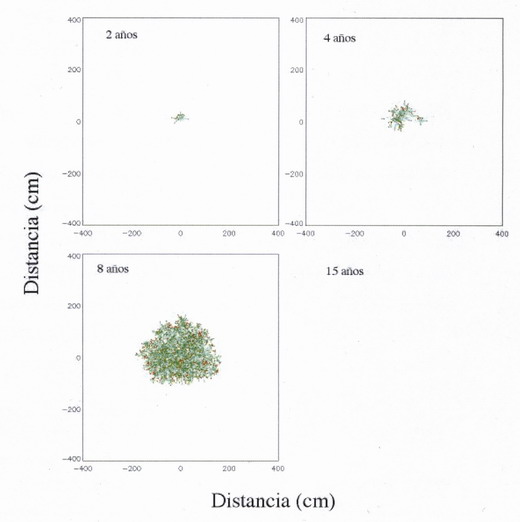Aims:
To develop a predictive model of the expansion of Caulerpa taxifolia and
Caulerpa prolifera through the comparative study of the regulation of
horizontal growth occurring in different substrates and environmental
conditions.
Plan:
To develop the action a company reputed for its expertise in this matter
was hired.
The work consisted in the elaboration of a survey to study the growth
norms of Caulerpa taxifolia and Caulerpa prolifera, in order to model
its expansion in Posidonia oceanica fields round the Balearics.
Methodology:
Monthly at location measurements, applying marking techniques, of the
elongation and ramification of the stolons, rate of frond formation and
ramification angle of the stolons of Caulerpa taxifolia and Caulerpa prolifera
growing in fields of Posidonia. Design of a numeric model based on the
empiric norms of clone growth , in order to simulate the clone expansion
of Caulerpa taxifolia and C.prolifera.
Development:
Monthly empiric estimates have been collected for one and a half years
in order to quantify the rules of annual clone growth that regulate the
growth of patches of C.taxifolia and C. prolifera (autochthonal species)
: distance between neighbouring fronds, elongation rate of the stolon
, ramification rate of the stolon , angle of ramification, and average
life span of the stolons and fronds.
Conclusions:
The results obtained indicate that in accordance with growth rules, C.taxifolia
would occupy space at a much slower rate than C.prolifera. For example,
C.taxifolia extends its stolons at a slower rate than C.prolifera (25.4
cms. year- 1 in C.taxifolia, 122 cms. year- 1 in C.prolifera). Based on
the obtained estimates of clone growth rules for both species, a numeric
model was then designed to simulate the growth of patches. The model predicts
that the development of a C.taxifolia patch is not linear where young
patches (3-5 years) increase their shape exponentially and grow in ramifications,
whereas the older patches increase their size more slowly and grow centrifugally.
Nevertheless, patches older than 8 years expand at a constant and maximum
rate (aprox.15 cm year-1).
This model assumes that occupation of space may be limited by competition
between fronds in the patch, but does not contemplate that there may be
competition between Caulerpa and other species. It is, however, possible
that the expansion of patches of C.taxifolia in Posidonia oceánica
fields which are in good state (i.e. not in decline) is limited by the
presence of P.oceanica. Whereas the model predicted that patches around
10 years old would have a diameter of 1-2 meters, in Cala d’Or,
where the invasion of C.taxifolia began in 1992, the diameter of the larges
patches was only of 0.6 m.
The model has been adjusted to simulate the development of C.prolifera
patches in order to be able to determine comparatively the capacity of
C.taxifolia to expand.
Due to the present low incidence of C.taxifolia and its
naturally occurring recession in Balearic waters, the modelling will be
useful in the hypothetical case that Caulerpa should begin to spread again,
as the model would make it possible to predict its expansion. This model
will make it easier to take measures to avoid any harm to Posidonia fields,
and can also be applied to model the growth of other species that may
affect Posidonia, for with the adequate parameters a simulation for any
species can be developed.
Thus, the aims of this action have been fulfilled as the goal was to model
the growth and spreading of C.taxifolia, although, for the moment, fortunately,
it is not necessary to apply the model as C.taxifolia in natural recession.

Graph of the model of expansion